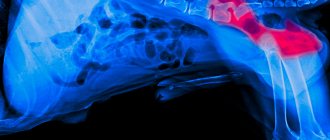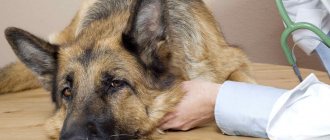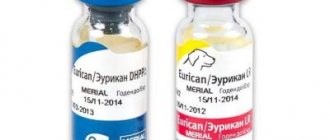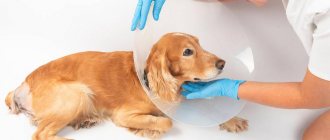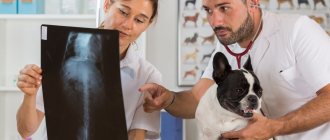Problems with joints impose a serious limitation on activity, which is very difficult for active and inquisitive pets. Such disorders include arthritis in dogs, which is often found in old age. Despite this feature, young animals are not immune from the disease, whose health may worsen under the influence of certain factors. Delayed treatment can result not only in complete loss of mobility, but also in amputation of the affected limb.
Description of the disease
There are many joints in a dog’s body, each of which has a different structure, depending on its location and function. The structure of any joint contains:
- cartilage;
- synovial fluid;
- joint capsule.
The mechanisms for the development of inflammation in joints are different, depending on the type of arthritis.
The bottom line is that joint deformation occurs due to the growth of granulation tissue in the synovial fluid (which washes and protects the cartilage). Granulation tissue eventually destroys the cartilage down to the bones.
Types of Arthritis
There are six main types of arthritis:
- Osteoarthritis.
- Rheumatoid.
- Idiopathic.
- Traumatic.
- Infectious.
- Drug.
Depending on the course of inflammation, the following are separately distinguished:
- Aseptic.
- Purulent.
Now more about each of them.
Osteoarthritis (functional)
The most common manifestation of the inflammatory process in the joint. It is observed in both small dogs and representatives of large breeds.
Predisposing factors may be different, but they are associated with increased load on the joint due to improper distribution of this load.
For example, due to obesity or, conversely, excessive physical activity, as well as due to improper skeletal structure.
All this leads to the fact that the joint wears out, tissue nutrition is disrupted and intra-articular cartilage is destroyed.
Rheumatoid arthritis
Chronic pathology, the membrane (shell) that encloses the synovial fluid becomes inflamed. This makes the joint less mobile, it swells, the ligaments surrounding it lose strength and the joint becomes deformed.
Most often, the root cause of such inflammation is the body itself, or rather the immune system. Sometimes your own antibodies begin to “attack” the cells of your own body - this happens with an autoimmune disease.
Miniature dogs are more susceptible to this. Most common in animals between 2 and 6 years of age.
In rheumatoid arthritis, the small joints are first affected, and then the inflammation can spread.
Idiopathic
Idiopathic arthritis is diagnosed last, when all other types have been excluded and the cause has not been identified. This group includes inflammation of unknown etiology (cause).
However, the main factors that influence idiopathic arthritis can be identified: cancer, diseases of the gastrointestinal tract, pathologies of the immune system and infectious diseases.
Traumatic
Inflammation due to mechanical impact on the joint, trauma. Moreover, the joint itself does not necessarily have to be injured; ligament ruptures can also lead to arthritis.
Inflammation of this type is usually acute, with sudden lameness due to pain and swelling from the very beginning of the pathology.
Infectious arthritis
It can develop due to the presence of an infectious disease that is not even related to the musculoskeletal system. Or maybe because of a wound in the joint area, with further penetration of pathogenic microflora into the damage cavity.
In this case, the inflammatory process may “remain” in the structure of the joint, or may spread to surrounding tissues (muscles and ligaments). Based on this, they distinguish:
- Synovitis is inflammation of the synovial membrane. Those. limited inflammation that does not spread further to other tissues.
- Panarthritis - inflammation from the joint spreads to the ligaments.
- Osteoarthritis.
- Infectious arthritis occurs with purulent inflammation.
Drug-induced arthritis
It occurs as a reaction of the body to a particular drug. This happens extremely rarely. May occur after vaccination or when using sulfur-containing drugs and some antibiotics.
However, you should not refuse vaccines or treatment due to the risk of developing drug-induced arthritis, since this probability is extremely low, and the benefits of vaccinations and treatment are much higher.
Causes
As already mentioned, arthritis can be an independent disease, or it can be a symptom of another disease.
Depending on the reasons that caused the inflammation and the form of the course, different types of arthritis are distinguished.
Often joint inflammation develops against the background of cartilage degeneration (arthrosis).
The most common causes that most often lead to arthrosis, and subsequently to osteoarthritis:
- Developmental pathologies. They can be caused by hereditary diseases, genetic disorders and much more.
- The animal is overweight. In this case, arthritis can also be metabolic, as it is also associated with metabolic disorders. And obesity puts a lot of stress on the joints.
- Irregular shape of the limbs (this often happens in small breed dogs).
- “Wear” of the joint. This happens when a certain joint (or several at once) is periodically subjected to a strong load for a long time. Usually observed in sports and service dogs.
Causes leading to other types of arthritis:
- immune disorders (idiopathic and rheumatoid arthritis);
- the use of certain medications (respectively, drug-induced arthritis);
- tumor pathologies (idiopathic);
- infectious pathologies;
- injuries (traumatic arthritis);
- inflammatory processes in other parts of the body.
Yersiniosis
Transmission routes
The natural reservoir of Yersinia are wild and domestic animals, mainly rodents (mice, rats), as well as pigs, less often dogs, cats, cows, etc. Infection mainly occurs through food products contaminated with animal excrement. Infection is possible when drinking water from open reservoirs. Due to the persistence of the pathogen in the external environment, contamination of products (milk, butter, vegetables, fruits, etc.) stored in refrigerators and vegetable stores is common.
Clinical signs
In the development of yersinia infection, several phases are distinguished: enteral, regional, generalized and the phase of secondary focal manifestations. The last two phases are associated with bacteremia, hematogenous foci of inflammation and septicemia.
There are intestinal, abdominal, septic, articular and icteric forms. In the septic form, multiple manifestations of septicemia are described: abscess pneumonia, purulent arthritis, osteomyelitis, etc. Arthritis develops during the period of a detailed clinical picture of the disease - from several days to 2 weeks or more from its onset. Most often, a few joints are affected (oligoarthritis).
Characterized by swelling of the joints, pain of varying intensity, skin hyperemia, limited function and other signs of inflammation. The lesions are often asymmetrical. The duration of arthritis symptoms ranges from several days to several weeks, and even months if the course is prolonged. Recovery, as a rule, occurs without residual effects, but relapses are possible.
Diagnostic features
Cytological examination. The synovial fluid is inflammatory in nature with high cytosis and a predominance of neutrophils.
Bacteriological culture of synovium and synovial membrane: The pathogen, as a rule, is not detected.
X-ray changes in the joints at the initial stage are not detected
The results of bacteriological analysis of feces, urine, and mucus from the throat for the presence of Yersinia during the first 2-3 weeks of the disease are decisive. The diagnosis is subsequently confirmed by the detection of yersinia antibodies in the blood serum in titers of 1:200 or higher and their decrease over time with repeated testing. The diagnosis of yersinia arthritis is based on the identification of yersiniosis in a patient.
Symptoms
Contrary to popular belief, arthritis does not only occur in dogs' limbs, inflammation can occur in any composition, and joints are found wherever there are bones.
So the most obvious sign in the first place will not be lameness, as it is logical to assume, but a deterioration in the general physical condition of the pet.
Therefore, it is very important to pay attention to any changes in the dog’s behavior.
The symptoms of arthritis are generally the same regardless of the type of inflammation. The time and degree of manifestation of signs of pathology may differ.
Main symptoms:
- Deterioration of condition, lethargy, the pet mostly lies down and moves reluctantly.
- Appetite decreases, but nevertheless the animal gains weight. This is due to the fact that the dog moves less.
- The place where the joint is inflamed becomes swollen. But this can be noticeable mainly only if the paw is affected, other joints are difficult to reach.
- Lameness or unnatural gait. The dog tries not to bend the affected area, which makes him very clumsy.
- The local temperature is elevated (only the site of inflammation is hot, and the rest of the body is at normal temperature).
- The affected area is very painful, so when touched, the dog may whine or show aggression, depending on temperament.
Osteoarthritis and arthritis in dogs and cats - signs and symptoms
These diseases may include one or more of the following symptoms:
- Lameness, reluctance to walk, climb stairs, jump or play, delayed walking
- Swelling and/or swelling in the joint area
- Pain in the joint area
- Licking affected joints
- Sometimes an increase in local temperature
- Change in behavior (sometimes aggression when touched)
- Crunching (crepitus) in the joint
- The animal carefully sits down or stands up, lies down after sleep - all these signs can also indicate arthritis
Symptoms will become more obvious as the arthritis progresses and the pain gets worse.
Diagnostics
High-quality diagnostics are only possible in a veterinary clinic.
- First, the doctor collects an anamnesis; you must be prepared to answer questions about the pet.
- The veterinarian then conducts a general examination of the dog, identifies the sore spot and examines it.
- Arthropuncture (puncture of the joint cavity) may be necessary. That is, they make a puncture and collect the fluid contained in the joint capsule. Conduct laboratory studies of the obtained material.
- To confirm the diagnosis, an x-ray is taken. Under ideal conditions, it is possible to perform a computed tomography or MRI, but in the vast majority of clinics this is not possible.
Treatment
Treatment should be prescribed exclusively by a veterinarian after a full diagnosis.
There are only two options. Treatment with drugs or surgery.
It all depends on the specific case.
- In some situations, it is enough to prescribe NSAIDs (non-steroidal anti-inflammatory drugs), select an antibiotic as necessary and carry out symptomatic therapy (painkillers, compresses, etc.).
- Sometimes it is necessary to rinse the joint. This need arises in case of purulent infectious arthritis. The method is called puncture. Disinfecting solutions and antibiotics are injected into the joint through a thick needle. This procedure is carried out until clear synovial fluid is obtained from the joint.
- In other cases, arthroscopy is necessary. Arthroscopy is a modern method that allows access to the joint without incisions, and through 2-3 access points with a diameter of about 2 mm using an endoscope. The arthroscopic method is used for both diagnosis and treatment.
- Whenever there is a disorder of the musculoskeletal system, it is advisable to transfer dogs to a special diet. The line of ready-made food for such cases is called Mobility.
- Treatment must be comprehensive; you cannot give your dog just one drug and hope that it will help.
Attention! The drugs cannot be prescribed independently and used without the supervision of a veterinarian.
The following medications may be prescribed as treatment aids:
"Stop - Arthritis" is available in the form of a suspension
"Artroglycan" tablets
"Horsepower" gel
"Ketofen" and "Rimadyl" - tablets and injections. Very careful use is required.
"Stride Plus" - syrup.
Prednisolone is a hormonal drug that requires special caution and is prescribed, literally, in precious doses.
"Hondatron" - drops or solution for injection and many others...
Also, it is necessary to understand that none of these drugs can be the only treatment - an integrated approach is required!
For better rehabilitation of the animal, it is necessary to introduce physical therapy into everyday life.
In cases of arthritis, massage and swimming are effective solutions. Such procedures reduce stress on the joints, while simultaneously increasing the tone of the muscles and ligaments.
Selection and tactics of selecting antibiotics for the treatment of infectious arthritis
- vancomycin + amikacin or
- vancomycin + cephalosporins 2-3-4 generations
or
- oxacillin + rifampicin. The duration of antibiotic therapy is about 6-8 weeks!
With borreliosis, determining the sensitivity to antibiotics of the pathogens that caused the disease in a particular patient is practically impossible.
During the development and course of Lyme disease, signs of infection are present at any stage, and therefore antibiotics are used at all stages of the disease.
Prevention
To prevent this pathology, first of all, the dog needs a balanced, nutritious diet.
It is also necessary to closely monitor the dog on the street to protect it from injury.
Some dogs are more susceptible to joint inflammation than others. These include large breed dogs, especially Labradors (also because they are prone to obesity), Bernese Mountain Dogs and Rottweilers due to their predisposition to hip dislocations.
Timely vaccination is also an integral part of the prevention of many diseases, in particular infectious arthritis.
Sufficient activity during the day and a soft, warm place to sleep should be available to each of our four-legged friends.
Preventive measures
Prevention of arthritis includes controlling your pet’s weight and a proper diet with the necessary supplements. Young animals should not be overloaded with physical activity: due to ill-conceived training, arthritis can develop. In addition, injuries and mechanical damage to the limbs should be prevented. Slippery floors are the most common cause of sprains in dogs. Frequent injuries displace the cartilage, which in turn will lead to inflammation of the joint. The animal should be protected from hypothermia and should not walk for a long time in damp and cold weather. To prevent your beloved pet from getting sick, it is recommended to visit your veterinarian regularly.
Dog care
During illness, the dog needs special care. In addition to a special therapeutic diet, you will have to make some other changes to your daily life:
- Walks should be short, less intense, but more often than usual.
- The dog must be warm.
- The pet's sleeping place should be soft and in a warm, dry place.
- If you live in a multi-storey building, do not force your pet to walk up the stairs, this is very painful during the period of illness and may delay the time until recovery. Use the elevator or carry your dog through stairs in your arms.
Popular questions
What painkillers should I give my dog for arthritis?
It is DANGEROUS to give any medications to your animal on your own without a doctor’s advice. Many painkillers have a lot of contraindications. Therefore, painkillers are selected for each dog individually.
Can it be treated with human medicine?
There are medications from humanitarian (human) medicine that are used in veterinary medicine. But they can only be used if they have been prescribed by a veterinarian.
The most important thing here is to strictly adhere to the dosage.
Under no circumstances should you give an animal a human dosage of the drug.
Briefly about the main thing
- Arthritis is an inflammatory disease of the joints.
- It can occur as an independent pathology, or as a result of other diseases or injuries.
- There are 6 main types of arthritis: osteoarthritis, rheumatoid, infectious, idiopathic, drug-induced and traumatic.
- The main causes of arthritis: excess weight, developmental pathologies, excessive physical activity, injuries, certain medications, autoimmune diseases, cancer.
- The main symptoms: lethargy, immobility, lameness, strange gait, loss of appetite, the site of inflammation increases in size.
- Treatment must be prescribed by a veterinarian; in some cases, you can only get by with medications and good care, while in others, surgery is necessary.
Have we answered your question fully enough? If not, post your question in the comments below and our veterinarian will answer it.
Did you like the article? Share it with your friends on social media. networks. This will help them get useful information and support our project.
Treatment for a dog with inflamed joints
If you suspect arthritis in dogs and notice the symptoms, treatment should begin as early as possible. However, only a veterinarian should select the method of therapy, based on the results of the examination and establishing the causes of the inflammatory process. Some animals are helped by alternative methods, others only by conservative ones.
- If the disease is just beginning, there is no acute pain or serious complications, then with the permission of the veterinarian you can resort to alternative treatment: herbs (for example, nettle, which has a good anti-inflammatory property), non-steroidal drugs (however, you should be extremely careful with them, since they can lead to serious complications), compresses with oil (lavender and juniper in equal proportions with warm water).
- The diet is being revised: tomatoes, grains, and potatoes are necessarily excluded. But egg yolks, seeds, ginger, and exotic fruits are great (but be careful with them so that the animal does not develop an allergy). Remember that there must be a diet so that the animal does not gain excess weight, which will only provoke the destruction of cartilage tissue.
- Drug treatment for arthritis in dogs includes the use of veterinary medications that have anti-inflammatory and analgesic properties. Chondroprotectors are also good. In some cases, surgical intervention is necessary (most often when the inflammation is of a traumatic nature).
- Improve living conditions. The pet's bed should be warm and soft, away from drafts. Cover all slippery surfaces on the floor with carpets and secure them, in general, so that the animal does not slip.
- Reduce the time spent on walks and put less stress on your beloved dog. Don't force him to run or jump, just calm movement. But remember that fresh air and sunlight have a beneficial effect on the health of the animal.
- Physiotherapy also has an excellent effect on recovery. Massage, phoresis, and swimming perfectly relieve pain and swelling of the joints. But all this should be done only after a face-to-face consultation with a veterinarian. Just remember that with purulent arthritis, heating (even with ointments) and massage, rubbing and other procedures that can lead to the outpouring of pus into the surrounding tissues are prohibited.
